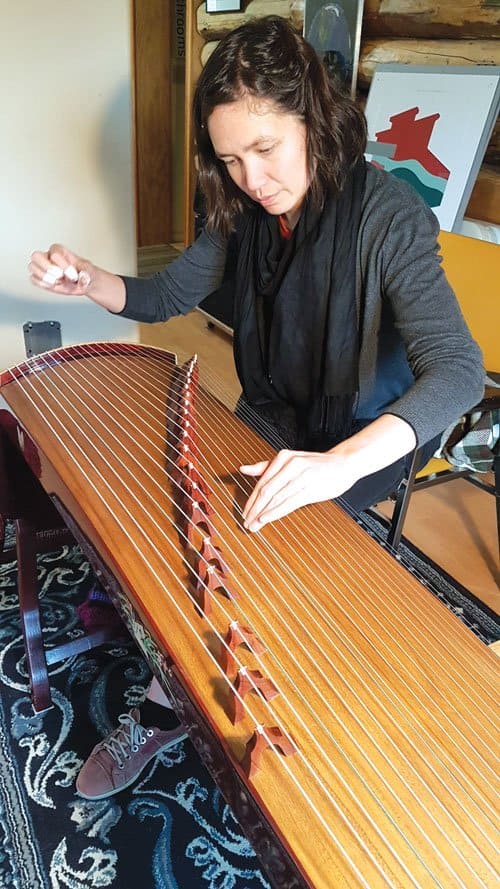Erica Mah riffs on the smaller of her two guzhengs
When you’re a working musician, a hobby always has the potential to become part of your pro kit. For Erica Mah, after roughly 10 years of dabbling with a traditional Chinese instrument called the guzheng, she’s now playing it for Whitehorse audiences. The guzheng is shaped like a narrow rectangle, about a metre and a half long, with 21, 25 or 26 strings. Each string has its own moveable bridge, which enables different tunings. The strings are plucked or strummed with the right hand, while the left hand modulates the sound.
Although the guzheng was novel to Mah, it is a commonly-played instrument in China, where children learn it much as Canadian children learn piano, violin or guitar. Mah first encountered the guzheng at the house of a friend, then borrowed it and eventually bought her own. She found a teacher in the Lower Mainland where she lived at the time. Mah most recently spent the month of October as the Jenni House resident, playing, composing and designing a visual art component to accompany her performance. Mah’s background in piano, guitar and several other instruments formed a solid base for learning the guzheng.
“It’s intuitive to me,” she says. “I play it much more like I would play a guitar. I use lots of chords, more rhythmic.”
Tuning is an aspect of the instrument she continues to explore. Each string has an individual, moveable bridge, which can be positioned in order to change the tuning. The guzheng is typically tuned in the pentatonic scale, which means there are five notes in a scale.
“I’ve turned it into a western-sounding instrument. To do that, I have to change some of the notes. The Chinese pentatonic scale has beautiful and interesting sounds, but we might not attach meaning to it in the same way because we’ve learned to respond to different scale sounds.”

She also composes songs on the guzheng in a similar way to composing on guitar and piano, but while also acknowledging the instrument’s capabilities. “I’m still learning the limitations. I need to learn how to set the strings based on the sound I want. Beyond that, it’s about finding a chord structure and a rhythm that works. The pentatonic scale is an open tuning, so there’s basically nothing you can do wrong.
“One thing different is that there are certain traditional techniques, like a sweep or a bend, that I like to add in, so it’s deciding where those fit. When I’m composing contemporary pieces, I want to have a bit of that to honour the capacity of this traditional instrument.”
She demonstrates some of those techniques. Pitch-bending is one, where the left hand modulates the note.
“It’s not unlike something in guitar called a hammer on,” she says. “You play an open string, then you add your finger to change the note. It’s different because you hear all the notes in between.”
Learning this particular instrument does have its challenges. Some flourishes or elements are written into the music through notations in Chinese characters. Although she doesn’t know the words, or how to pronounce them, Mah can recognize the characters and their meanings within the music.
The guzheng can also tax the body. “The guzheng is a physically demanding instrument because of the finger dexterity—it’s a lot like a harp. There’s a lot of different ways to play and some are really fast. I have very hard callouses.” As many have observed during the pandemic, learning remotely can be vexing. Mah uses a combination of videos and FaceTime lessons with her teacher.
“Because of the lag, we can’t play together. The urge to match and play together is so strong, but you know it’s going to sound like garbage. It’s tricky to take turns.”




